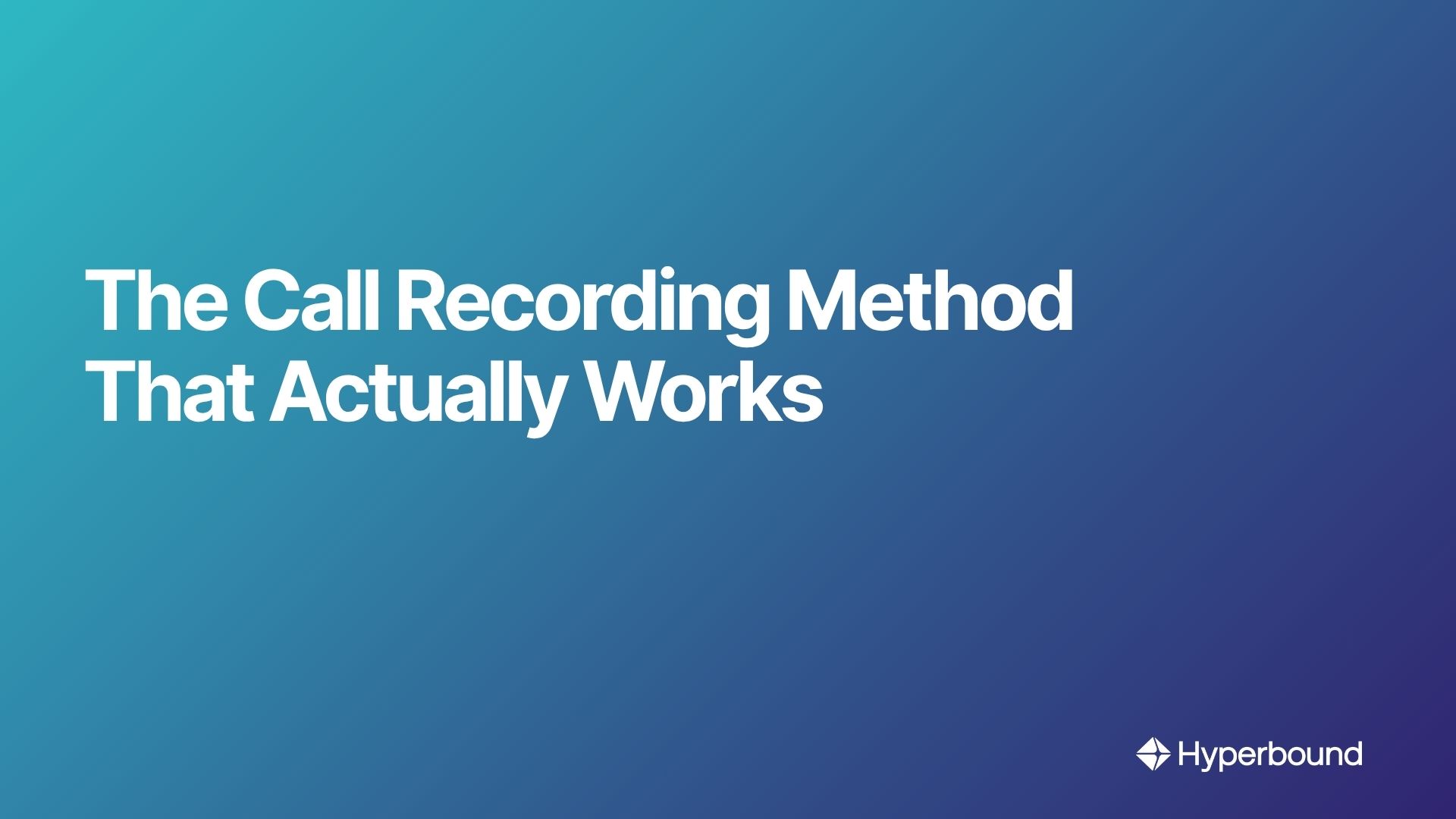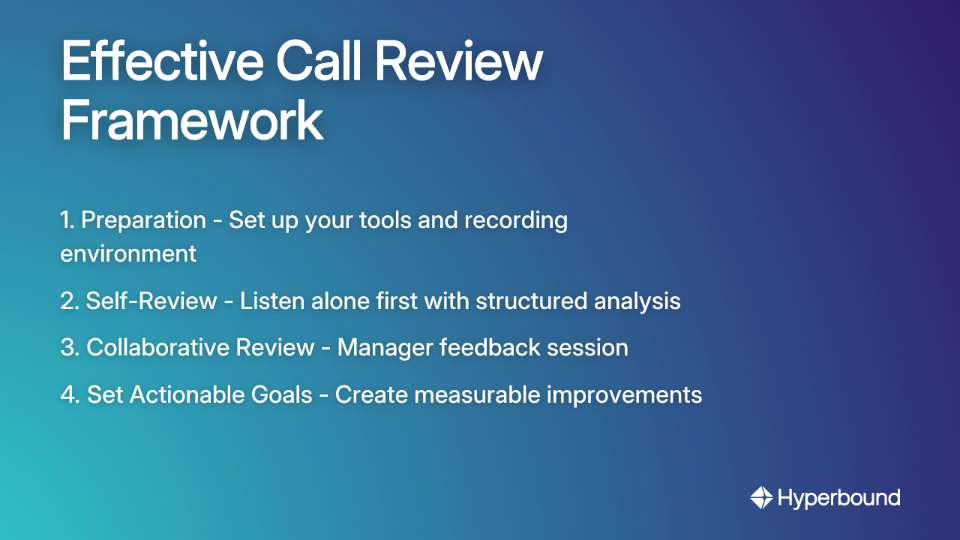
You've just finished a sales call. It felt decent – you covered your main points, the prospect seemed engaged, and you even booked a follow-up. But later, when you listen to the recording, you cringe at every "um," awkward pause, and that moment when you stumbled through explaining your pricing structure.
Recording sales calls is universally described as "the most painful thing" by SaaS sales professionals. And yet, the follow-up sentiment is almost always the same: "but damn if it doesn't get you to improve."
If you've ever listened to your own voice and thought, "I sound so fake and 'salespersony'," you're not alone. But what if there was a structured approach to turn those cringe-worthy moments into breakthrough insights?
Why Most Call Reviews Fail (And Why It's Still Worth It)
Many organizations make a critical mistake with call recordings: they listen without structure, focus on blame rather than improvement, and fail to create a positive coaching atmosphere. This approach not only wastes time but can damage a rep's confidence.
Despite these challenges, the data shows call recording remains essential:

- Pipeline Generation: According to a 2024 State of Sales Development report, 54% of companies focus on pipeline generation via call recording and analytics.
- Objective Analysis: Call recordings provide factual performance evaluations, not gut feelings or selective memory.
- Uncover the 'Why': Recordings reveal why deals are won or lost—was the value proposition unclear, did messaging miss, or were competitors more appealing?
- Customer & Competitive Intelligence: Direct customer feedback, objections, and competitor mentions become valuable intelligence for your entire organization.
A customer care rep who transitioned to SaaS sales after years in another industry shared: "Recording myself and listening back with my manager is how it clicked for me. I realized how unnatural I sounded trying to use the boilerplate pitch."
The Step-by-Step Framework for Effective Call Review

Step 1: Preparation - Set the Stage for Success
Choose Your Tools & Settings:Select the right recording solution for your needs. Conversation intelligence platforms like Hyperbound, Gong, Revenue.io, and CallRail can automatically record and transcribe calls. Configure your settings for automatic or on-demand recording, and always ensure you inform participants to maintain legal compliance.
Pro tip: Leverage platforms with AI Real Call Scoring to get automated summaries, objective scoring against your playbook, and pinpoint key moments for coaching.
Step 2: The Self-Review - Listen Alone First
Before sharing with managers, listen to your call privately. This critical step builds self-awareness and reduces the anxiety that comes with external feedback.
"Most reps hate this but it's the fastest way to improve," explains a veteran sales manager. "Having them self-assess first promotes ownership and makes the subsequent manager review more productive."
Use the Self-Analysis Checklist (provided later) to guide your review and take notes on specific moments that need attention.
Step 3: The Collaborative Review - The Manager Feedback Session
Frame feedback sessions as coaching opportunities, not critiques. A healthy feedback loop transforms uncomfortable moments into growth opportunities.
Use a structured template (shared below) and follow these best practices:
- Reference specific call moments with timestamps
- Balance strengths and areas for improvement
- Offer concrete, actionable advice for improvement
One SaaS rep shared: "My confidence improved dramatically once my manager started highlighting what I did well, not just where I messed up."
Step 4: Set Actionable Goals
The review is meaningless without clear next steps. Define measurable goals based on your analysis:
- "Reduce filler words by 50% on next week's calls"
- "Practice the new objection handling technique in three mock calls before Friday"
Create a Call Library of both good and bad examples for ongoing training. As your team builds this resource, reps can learn from each other's successes and struggles.
What to Analyze: Deconstructing Your Call for Breakthrough Moments
Pacing and Pauses
Problem: Rushing through your pitch due to nerves.
What to listen for: Are you speaking too quickly? Are there natural pauses that allow the prospect to digest information?
Actionable Tip: "Take more pauses between sentences and concepts," advises a top-performing rep on Reddit. Count to 3 after a prospect finishes talking to avoid interrupting and appear more thoughtful.
Tonality and Inflection
Problem: Sounding monotonous, "salesy," or lacking confidence.
What to listen for: Voice modulation throughout the call. Do you use downward inflection to sound more authoritative when making key points?
Actionable Tip: "Stand up during calls. Seriously. Your physical posture directly impacts your vocal tonality." If you struggle with confidence, try conveying genuine excitement about your product – enthusiasm is contagious and often more authentic than forced confidence.
Filler Words and Qualifiers
Problem: Using words that undermine your authority and expertise.
What to listen for: Count the "ums," "ahs," "likes," and "you knows." Also note qualifiers like "just," "kind of," "I think," and "possibly."
Actionable Tip: Replace qualifiers with confident statements or a deliberate pause. One sales leader recommends: "Record yourself reading the same script five times, focusing on eliminating one filler word each time."
Talk-to-Listen Ratio
Problem: Dominating the conversation instead of letting the prospect talk.
What to listen for: How much time are you speaking versus listening? The best reps typically maintain a 40:60 talk-to-listen ratio.
Actionable Tip: Use conversation intelligence tools to track this metric objectively. Practice asking open-ended questions that encourage prospects to elaborate.
Objection Handling
Problem: Fumbling when faced with prospect objections.
What to listen for: Pinpoint the exact moment an objection was raised. How did you respond? Did you get defensive, sound uncertain, or handle it confidently?
Actionable Tip: Build a library of effective objection handles from your team's best calls. Practice them using AI roleplays to prepare for any scenario. For more strategies, analyze top performers' calls to see how they overcome objections in sales.

Tools for the Trade: Checklists & Templates to Implement Today
The Ultimate Self-Analysis Checklist
Use this checklist when reviewing your own calls:
- What went well? Where did I build rapport effectively?
- What could I have done differently? At what timestamp did I miss a cue?
- How would I rate my use of filler words and qualifiers (1-5)?
- Did my opener engage the prospect, or was it too generic?
- Did I listen actively, or was I waiting for my turn to speak?
- How effectively did I handle objections?
- What was the customer's emotional response at key moments?
- Did my tone and pace match the energy of the conversation?
- Was I using industry jargon appropriately for this specific prospect?
Manager Feedback Session Template
Call Details:
- Rep Name:
- Prospect/Company:
- Date/Time:
- Call Duration:
- Call Objective:
Key Outcomes:
- Was the objective met? (Meeting booked, lead qualified, etc.)
- Next steps agreed upon:
Key Highlights (Strengths):
- Timestamped Comment: (e.g., @2:15 - Great use of a pause here, it made the prospect lean in).
- Timestamped Comment: (e.g., @4:30 - Excellent handling of the pricing objection).
Areas for Improvement:
- Timestamped Comment & Rating (1-5): (e.g., @1:10 - Tonality was flat here. Practice standing up to inject more energy. Rating: 2).
- Timestamped Comment & Rating (1-5): (e.g., @5:45 - Used "kind of" three times, which weakened the statement. Work on eliminating qualifiers. Rating: 3).
Action Items (Next Steps):
- Rep: Practice opening pitch with more energy in 2 mock calls this week.
- Manager: Share two examples from the Call Library of strong opening pitches.
From Cringe to Confidence
Remember what one successful rep discovered: "The calls that I 'care' the least about end up being the best." This insight reveals a powerful truth – when we shift our mindset from "be perfect" to "it doesn't matter if this meeting goes well," we often perform more naturally and authentically.
Recording calls isn't about achieving perfection; it's about continuous improvement. Even the most experienced reps review their calls regularly to refine their approach.
By implementing this systematic, collaborative call review process, you can transform those uncomfortable, cringe-worthy moments into your most powerful learning experiences. The result? Reduced anxiety, increased confidence, and ultimately, a stronger pipeline and more closed deals.
The most painful thing might just be your biggest opportunity for growth.

Frequently Asked Questions
What is the most effective way to review sales calls?
The most effective way to review sales calls is by using a structured, four-step framework: Preparation, Self-Review, Collaborative Review, and setting Actionable Goals. This structured approach ensures you move beyond simply listening and start systematically analyzing performance. It involves using the right tools, assessing your own performance first to build self-awareness, engaging in a constructive coaching session with a manager, and defining clear, measurable steps for improvement.
How can I sound more confident and less "salesy" on calls?
To sound more confident and less "salesy," focus on improving your tonality and pacing. Key techniques include standing up during calls to improve posture and energy, using downward inflection on key points, and practicing deliberate pauses. Rushing through your pitch or speaking in a monotone voice often comes across as nervous or inauthentic. Recording yourself allows you to hear this. Try conveying genuine enthusiasm for your product instead of forcing confidence.
What is a good talk-to-listen ratio for sales calls?
A good talk-to-listen ratio for most sales calls is approximately 40:60, meaning the sales representative speaks for about 40% of the time and listens for the remaining 60%. This ratio ensures that you are not dominating the conversation and are actively listening to understand the prospect's needs, pain points, and questions. You can use conversation intelligence software to track this metric automatically and improve by asking more open-ended questions.
How often should sales reps review their calls?
For consistent improvement, you should aim to self-review at least one to two calls per week, with a more in-depth collaborative review with a manager happening weekly or bi-weekly. The key is consistency, not just volume. Regular, structured reviews help you build and maintain good habits. Reviewing a mix of successful and unsuccessful calls will provide the broadest range of learning opportunities.
What are the biggest mistakes to avoid during call reviews?
The biggest mistakes to avoid during call reviews are listening without a clear purpose, focusing on blame instead of coaching, and failing to set actionable follow-up goals. A review session should be a positive, constructive experience. Without a structured checklist or framework, it's easy to get lost or only focus on negative aspects. Always balance feedback on areas for improvement with acknowledgment of strengths to maintain confidence and morale.
Why is self-review important before a manager coaching session?
Self-review is crucial because it promotes ownership and self-awareness, allowing you to identify your own strengths and weaknesses before receiving external feedback. Listening to your own call privately first helps reduce the anxiety associated with being critiqued. It also makes the subsequent coaching session with a manager more productive, as you can come prepared with your own observations and questions, leading to a more collaborative and effective discussion.
Book a demo with Hyperbound
.png)













